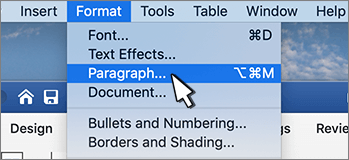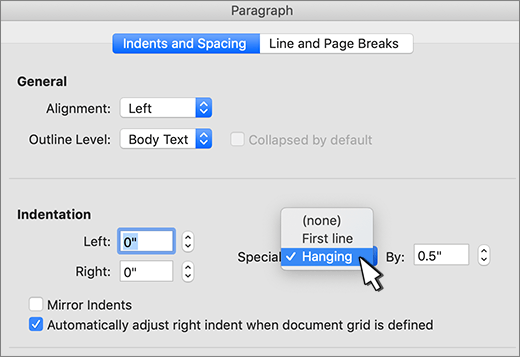






It is important that students understand the distinction between the terms topic, title and research question.

Candidates must declare their word count on the TITLE page of the EE.  As you need to upload an
As you need to upload an
electronic version of your EE, it becomes very easy for the examiner to determine where the essay has reached 4,000 words (the word limit).
The upper limit is 4,000 words for all ExtendedEssays.

The following font is required: the use of 12-point, readable font (Times New Roman / Arial)


AVOID:

Your research paper ends with a list of all the sources cited in the text of the paper. This is called a Works Cited list.



Open a new Microsoft Word document
Select: Paragraph
Select: Special - Hanging 0.5"
Indentation: Left: 0"
Indentation: Right: 0"
Spacing: Before: 0pt
Spacing: After: 0pt
Line Spacing: Double
Do not add extra space between citations.
Select the paragraph where you want to add a hanging indent.
Go to Format > Paragraph.

Under Special, select Hanging.

You can adjust the depth of the indent using the By field.
Select OK.
It is acceptable to include tables to show data and/or information related to the research question. Tables must never be used in an attempt to exceed the 4,000-word limit as this will get detected.



Level Descriptor
0 The work does not reach a standard outlined by the descriptors below.
1–2 Presentation is acceptable.
• The structure of the essay is generally appropriate in terms of the expected conventions for the topic, argument and subject in which the essay is registered.
• Some layout considerations may be missing or applied incorrectly.
• Weaknesses in the structure and/or layout do not significantly impact the reading, understanding or evaluation of the extended essay.
3–4 Presentation is good.
• The structure of the essay clearly is appropriate in terms of the expected conventions for the topic, the argument and subject in which the essay is registered.
• Layout considerations are present and applied correctly.
• The structure and layout support the reading, understanding and evaluation of the extended essay.
The IB is very clear when it says the Title Page (Cover Page) should have the following key information:
At CAJCS we also like to include. 
Do not include. 
EXAMPLE OF A TITLE PAGE


“A contents page must be provided at the beginning of the extended essay and all pages should be numbered. Please note that an index page is not required and if included will be treated as if it is not present.” From the IB Extended Essay Guide.

EXAMPLE OF TABLE OF CONTENTS

TABLE OF CONTENTS EXAMPLE - SCIENCE EE

As part of the Presentation criteria, it is mandatory to double space your essay. This allows examiners to insert annotations when marking it while also making for a smoother reading experience. If you are using MS Word (PC), the spacing option appears here:


All images used in an Extended Essay should appear as near as possible to where you first reference them in the text. The images should contain a fully referenced caption as seen below:

Fig. 1: Vinci, Leonardo Da. Mono Lisa. Musee du Louvre.
Lo Gioconda.Paris, 1503-1506. Oil Painting
COMPLETE BIBLIOGRAPHY UNDER THE IMAGE. IN THIS CASE NO NEED FOR LIST OF FIGURES

IMAGE WITH CAPTIONS AND COMPLETE BIBLIOGRAPHY IN THE LIST OF FIGURES




Works Consulted: is the term used for the list of sources used in the preparation of a research project. It is used to list background reading, summarized sources, or any sources used for informational purposes but not paraphrased or quoted. It is used to document those sources referred to, but not cited in your Essay.
Works Cited: is the term for the list of sources actually documented (paraphrased or quoted) in your project, generally through parenthetical citation. All of the parenthetical references in the Essay should lead the reader to this list of sources.
Should I use one or both?
A student might prepare only a Works Consulted page if he or she did not quote or paraphrase at all in the project.
A student might prepare only a Works Cited page if he or she paraphrased or quoted from and therefore cited all sources used.
A student might prepare both Works Consulted and Works Cited pages if, in addition to the sources cited in the project or paper, he or she also consulted other sources that were not paraphrased or quoted.
Preparing the Works Cited and Works Consulted Pages:
·Head a new sheet of paper “Works Cited” or “Works Consulted” (Do not use quotation marks around your title.)
·Alphabetize your sources by author, or first entry, which may be an association or a title, if no author is noted. This should be easy if you have collected source cards.
·Place the “Works Cited” page(s) immediately after the last page of the text.
·If your paper includes both Works Cited and Works Consulted, the Works Consulted page should follow the Works Cited page.
Appendices are not a necessary component of the EE. Alhough they tend to be used to provide  supplementary evidence of the research conducted, examiners are not expected or required to read the information in the appendices. Therefore, if you choose to include items in the appendices, make sure the materials have direct relevance to your analysis, arguments and conclusion. The following are examples of what is acceptable to include in the appendices:
supplementary evidence of the research conducted, examiners are not expected or required to read the information in the appendices. Therefore, if you choose to include items in the appendices, make sure the materials have direct relevance to your analysis, arguments and conclusion. The following are examples of what is acceptable to include in the appendices:
■ Copy of a completed questionnaire used as primary research in the essay
■ Transcript of interview questions and answers used as part of the research in the essay
■ Copy of any permission letters to carry out research for academic purposes
■ Copies of poems or short stories (of less than three pages) for EEs in Group 1,
category 1 and in language acquisition, category 3
■ Excerpts from newspapers, advertisements and transcripts of speeches for EEs in
Group 1, category 3 and in language acquisition, category 1 and 2
■ Raw data or statistical tables for EEs in experimental sciences.
In all the above cases, there should not be any analysis, discussion or conclusions included in the appendices. Although citation and referencing are an integral aspect of academic writing, you should avoid continually referring to the materials in the appendices. Examiners are not expected to refer to the materials there and it could disrupt the flow of the essay as they read and mark your work.
in the appendices. Although citation and referencing are an integral aspect of academic writing, you should avoid continually referring to the materials in the appendices. Examiners are not expected to refer to the materials there and it could disrupt the flow of the essay as they read and mark your work.